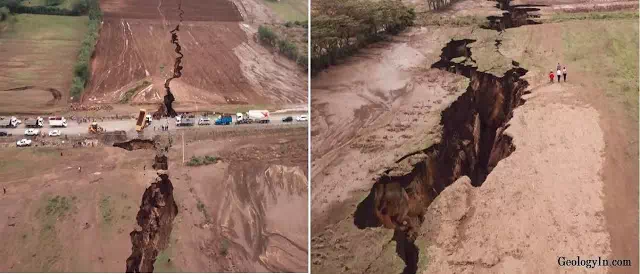
As It Turns out we soon may have two mother countries. The East African rift system encompassed the western and eastern rifts of the continent and extended from the Afar region of Ethiopia to Mozambique. It is an active continental fracture that began millions of years ago, splitting at 7mm per year. Regular volcanic eruptions along the rift and a fresh look at the breakdown of continents heighten the perception that a continent could break apart, creating a new ocean. Geologists studying the tectonics of the African plate discovered that the continent of 54 countries is splitting.
The fault line, known as the Great Rift Valley, extends from the Afar region in northern Ethiopia to Mozambique, cutting off the eastern coastal countries including Kenya and Tanzania from most of the task force.
According to a new study published in the journal Nature, the two lands are opened at a rate of seven millimetres a year. As it happens, countries such as Uganda and Zambia will have their own coastlines.
Along the rift valley, scientists say that a series of active volcanoes, such as Ol Doinyo Lengai in Tanzania and Alu-DallaFilla in Ethiopia, are providing new ideas for this process. In particular, Erta Ale, an Ethiopian volcano, has existed as a permanent eruption for more than 50 years.
In a recent study, it was found that the Victorian microplate located between the east and west sides of the rift valley has rotated counterclockwise relative to the African plate in the past two years. The African plate is the main tectonic plate that constitutes most of the African continent. It was found that the microplate was rotating in the opposite direction to all other adjacent microplates in the area.
Between the two sides of the rift, the Victoria Microplate is the largest microplate of its kind on the planet, and has been rotating counterclockwise for the past two years. For all other plates on the African continent, including the main African plate, the Victoria microplate is turning in the opposite direction. According to scientists, this anomaly may accelerate the separation of the rift valley.
Although this provides researchers with new insights into the division process of the East African Rift Valley system, the "Y"-shaped end of the rift valley in the Afar region has attracted more and more attention, that is, where the ocean may be formed if the division continues. The "Y" junction is where the African, Somali and Arabian tectonic plates meet near Djibouti and Eritrea, and is related to active volcanoes (including Elta El volcano).
Scientists mark the Y-junction where the tectonic plates of Africa, Somalia and Arabia meet, between Djibouti and Eritrea, as the place where the ocean will begin to form.
Researchers believe that volcanic activity in the area hints at the transition from a rift valley to a ridge. Erta beer has continued to erupt for more than 50 years. It is believed that as Erta beer continues to erupt, a new narrow ocean basin and its mid-ocean ridge will be formed.
However, researchers are not sure about the future of the East African Rift-whether the division will continue and eventually form an ocean. At the rate that the Afar Rift divides, it will take tens of millions of years to form the ocean.
Scientists say they are unsure of the fate of the two land masses and whether a new ocean will form, but note that it will take tens of millions of years to establish.
Coming Soon...!
Comments (0)